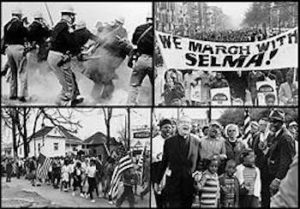
*On this date in 1965, the Selma to Montgomery marches began. Lasting three weeks, there were three American Civil Rights protest marches held along the highway from Selma, Alabama, to the state capital of Montgomery (54 miles).
Nonviolent activists organized the marches to demonstrate the desire of African American citizens to exercise their constitutional right to vote in defiance of segregationist repression; they were part of a broader voting rights movement underway in Selma and throughout the American South. By highlighting racial injustice, they contributed to the passage of the Voting Rights Act, a landmark federal achievement of the civil rights movement. Southern state legislatures had passed and maintained a series of discriminatory requirements and practices that had excluded most of the millions of African Americans across the South throughout the 20th century.
The African American group known as the Dallas County Voters League (DCVL) launched a voter registration campaign in Selma in 1963. Joined by organizers from the Student Nonviolent Coordinating Committee (SNCC), they began working that year in a renewed effort to register black voters. Finding resistance by white officials to be stubborn, even after the Civil Rights Act of 1964 ended legal segregation, the DCVL invited Rev. Martin Luther King, Jr. and the Southern Christian Leadership Conference (SCLC) to join them. SCLC brought many prominent civil rights and civic leaders to Selma in January 1965.
Local and regional protests began, with 3,000 people arrested by the end of February. President Johnson and King talked by telephone on January 15 to plan a strategy for drawing attention to the injustice of using literacy tests and other barriers to stop Black Southerners from voting. King later informed the President on February 9 of his decision to use Selma to achieve this objective. On February 26, 1965, activist and deacon Jimmie Lee Jackson died after being shot several days earlier by state trooper James Bonard Fowler during a peaceful march in nearby Marion, Alabama. To defuse and refocus the community's outrage, SCLC Director of Direct Action James Bevel called for a march of dramatic length from Selma to the state capital of Montgomery.
The first march occurred on March 7, 1965, and was organized locally by Bevel, Amelia Boynton, and others. State troopers and county posse men attacked the unarmed marchers with Billy clubs and tear gas after they passed over the county line, and the event became known as Bloody Sunday. Law enforcement beat Boynton unconscious, and the media publicized worldwide a picture of her lying wounded on the Edmund Pettus Bridge.
The second march took place on March 9. Troopers, police, and marchers confronted each other at the county end of the bridge, but when the troopers stepped aside to let them pass, King led them back to the church. He obeyed a federal injunction while seeking protection from the federal court for the march. That night, a white group beat and murdered civil rights activist James Reeb, a Unitarian Universalist minister from Boston, who had come to Selma to march with the second group. Many other clergy and sympathizers from the country also gathered for the second march. The violence of "Bloody Sunday" and Reeb's murder resulted in a national outcry and some acts of civil disobedience, targeting the Alabama and federal governments.
The protesters demanded protection for the Selma marchers and a new federal voting rights law to enable Blacks to register and vote without harassment. President Johnson held a historic, nationally televised joint session of Congress on March 15 to ask for the bill's introduction and passage. With Governor Wallace refusing to protect the marchers, President Johnson committed. The third march started on March 21. Protected by 1,900 members of the Alabama National Guard under federal command and many FBI agents and federal marshals, the marchers averaged 10 miles a day along U.S. Route 80. The marchers arrived in Montgomery on March 24 and at the Alabama State Capitol on March 25. With thousands joining the campaign, 25,000 people entered the capital city that day to support voting rights. The route is memorialized as the "Selma To Montgomery Voting Rights Trail” and is designated as a U.S. National Historic Trail. The Voting Rights Act became law on August 6, 1965.